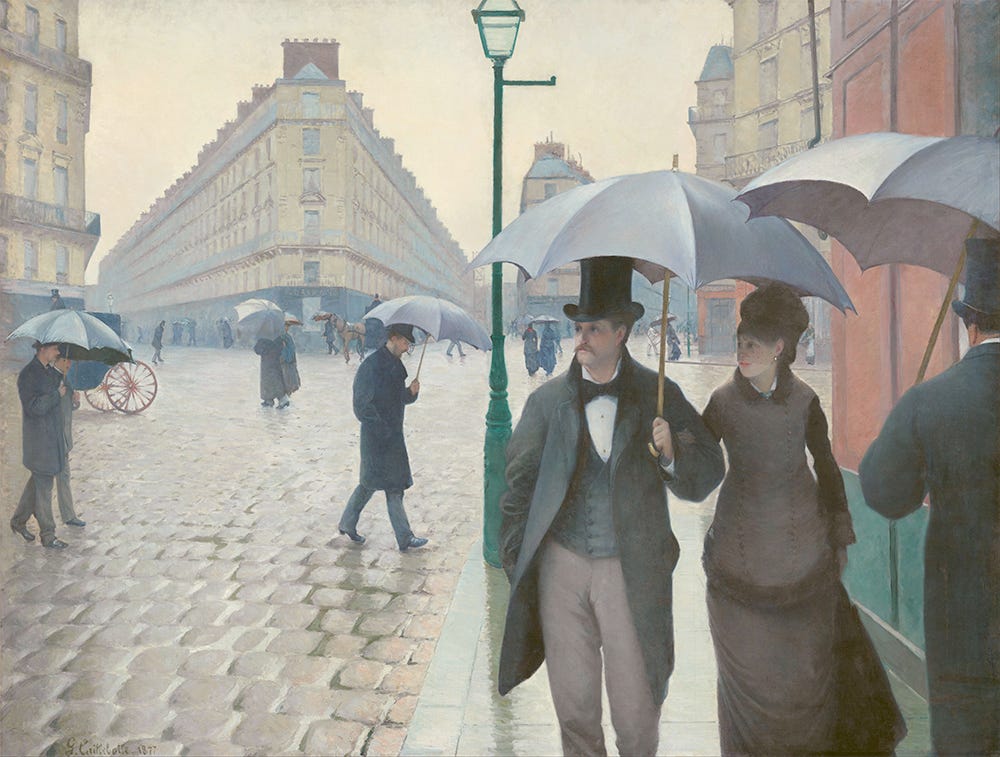Visual Sense
"What a person or animal perceives is not only an arrangement of objects, of colors and shapes, of movements and sizes. It is, perhaps first of all, an interplay of directed tensions. These tensions are not something the observer adds, for reasons of his own, to static images. Rather, these tensions are as inherent in any percept as size, shape, location, or color. Because they have magnitude and direction, these tensions can be described as psychological "forces."
Rudolf Arnheim. Art & Visual Perception. 1974.
A few days ago I came across this interesting article about patterns in art. The article, entitled The Pleasure of Patterns in Art takes a dive into Gustave Caillebotte’s painting Paris Street;Rainy Day and proceeds to analyse the various elements as well as the how those elements work together within the perceptive field. It pinpoints phenomena that took me back to when I was reading a lot on this subject. Mostly what I taught as gestalt theory to my students. It was also a stern reminder of a project I set up back in 2020 and for which I’d dearly like to find the time to accord further development.
Back then I got quite heavily into this question of how we see a work of art and equally as a practicing artist how an image is created. One of the first references I ever read on the subject was E.H.Gombrich’s Art and Illusion. One of his lesser-known titles, which is a truly brilliant exploration of the history and psychology of pictorial representation. From here I discovered Rudolf Arnheim’s foundational work from the sixties and this opened up a whole realm of thought that profoundly changed the way I thought about images.
We first see images and we make up our minds very quickly about whether that image is of interest to us or not. Seeing however is the easy part, it’s about what happens when we dig a little deeper. When we begin to read images. Looking carefully at what meets the eye can be a most revealing activity. We can of course read an image from various angles; we can take into consideration its history, or look into a biography of the artist for example. The one I’m highlighting here is purely formal. It’s looking at what are the graphic elements and how they have been composed. Going beyond subject matter and searching for those slightly more hidden meanings. It’s about opening up the sense of sight and trying to fully grasp why one image has perhaps more meaning to you than another. And I’m using meaning quite loosely here but what I’m getting at is that the pleasure we may sense in an image, usually has something to do with its symmetry, its repetition, its positioning of form and all those various features which build up the concept of the image before us.
Now, to jump back to my initial thought on that article I stumbled across. There is on the web a little space I called the Computation Graphic Design Manual. The beginnings of this project had taken form during that time of intense interest in the psychology of the image. And I wanted to bring that into my teachings and understandings with creative coding. I had managed a semester with my students working with these principles of gestalt and how they may be both transferred to and translated with code. The results were positive and promising but I never created the time to push it further. It has been sitting there on the shelf for some time now. Like a mental itch albeit not so present. That is until a random article comes my way and gets the motivation flooding. If anyone is interested in working on this with me, please reach out. I had been working with RNDR with this for a while and it would be nice to continue that too.
Signing off here today but I have been entertaining a good number of ideas for future letters. So please stay tuned.
You may well know that I recently published a book on two of my artistic works. Hyper & Cosmic is published by Vetro Editions and can be ordered here. Please consider supporting. Kind regards.


Thanks for sharing The Pleasure of Patterns in Art. Great article.